You might be interested in buying onyx, already own some pieces, or are simply curious about this captivating stone. If you are, then you must know how to identify onyx as it’s often confused with other crystals and gemstones.
In this article, we’ll dive into this gem, exploring what makes it unique and how you to tell if an onyx is real or fake. There are several key features to look for that can help you distinguish real onyx from fakes, and we’ll go through all of them here.
With these helpful tips, you can feel confident in identifying genuine onyx. They will be easy to understand and won’t require any special tools or expert knowledge, so no need to wait any further. Let’s begin!
Overview Of Natural Onyx And Why Fakes Are Common
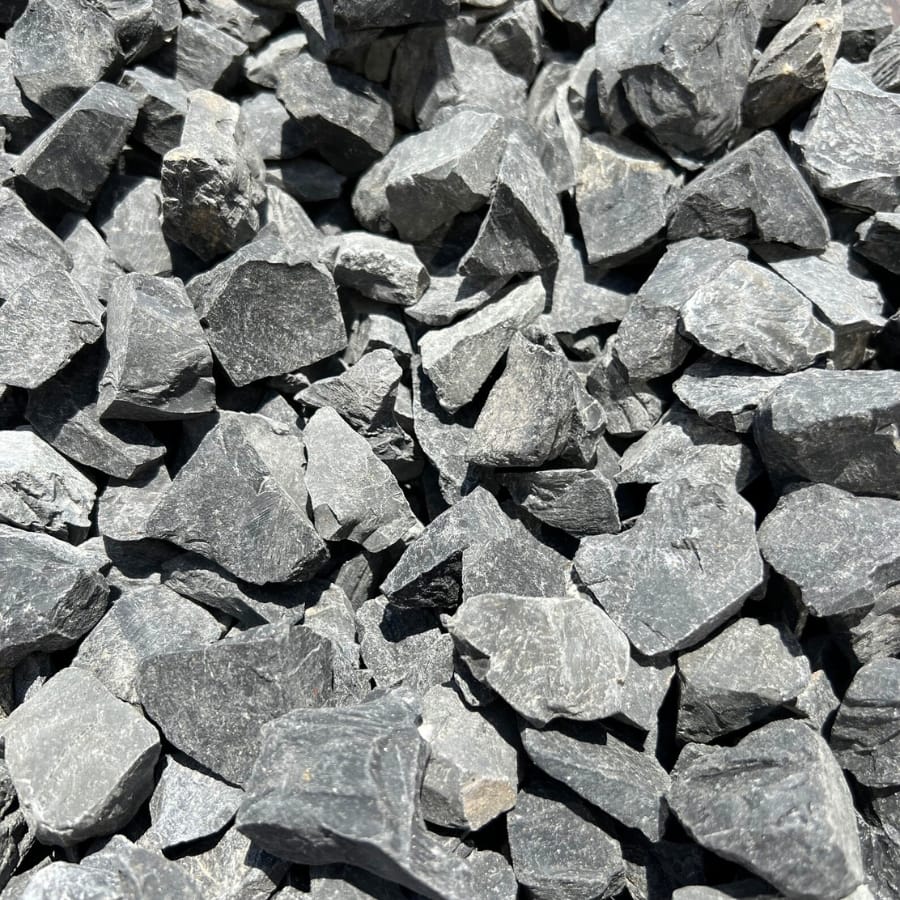
Onyx is part of the chalcedony family that has bands of colors, usually black and white. It forms when silica gets deposited in lava and other areas where volcanic activity occurs. Over time, it cools and crystallizes, forming the bands of onyx.
The layers in onyx are usually parallel and can vary in color based on the different types of minerals present during its formation.
One of its unique properties is its ability to be dyed into other colors to enhance its appearance. This makes it versatile for various uses, especially in jewelry. It’s also quite hard, scoring a 7 on the Mohs Scale of mineral hardness, so it’s durable and resistant to scratches.
Because of these qualities, onyx is commonly used in jewelry. Its striking bands make it a popular choice for both men’s and women’s jewelry. It’s also used for decorative items like vases, bowls, and even in architecture.
The value of onyx is influenced by its rarity and the skill required to craft it into beautiful objects. Also, because of its long history and use in ancient artifacts, it has a kind of timeless appeal that makes it special to many people.
Why you’re seeing more fake onyx these days
The rise in fake onyx stones in the market is happening for a few reasons. First, it’s really popular and loved for its sleek, elegant look and the cool bands of color it has. Because it’s in high demand, some people try to make fake ones to make money.
Making fake onyx is easier as it can be made quickly in a factory. They use materials like plastic or glass, which are much cheaper, too. These fakes can look pretty close to the real thing if you don’t know what to look for.
Real onyx, on the other hand, takes a long time to form in nature and needs to be carefully cut and polished.
Another reason for the increase in fakes is technology. With better tools and machines, making a stone that looks like onyx is easier than ever. Some fakes are even made from other less expensive stones that are treated with dyes and chemicals to look like onyx.
With the high demand for onyx and the ease of making fakes, it’s not surprising that more of them are showing up.
How To Identify Real Onyx
It will be very helpful to know how to identify rocks if you want to avoid mistaking a fake for a real one. In the case of onyx, here are some practical tips to identify it:
Look at the color bands
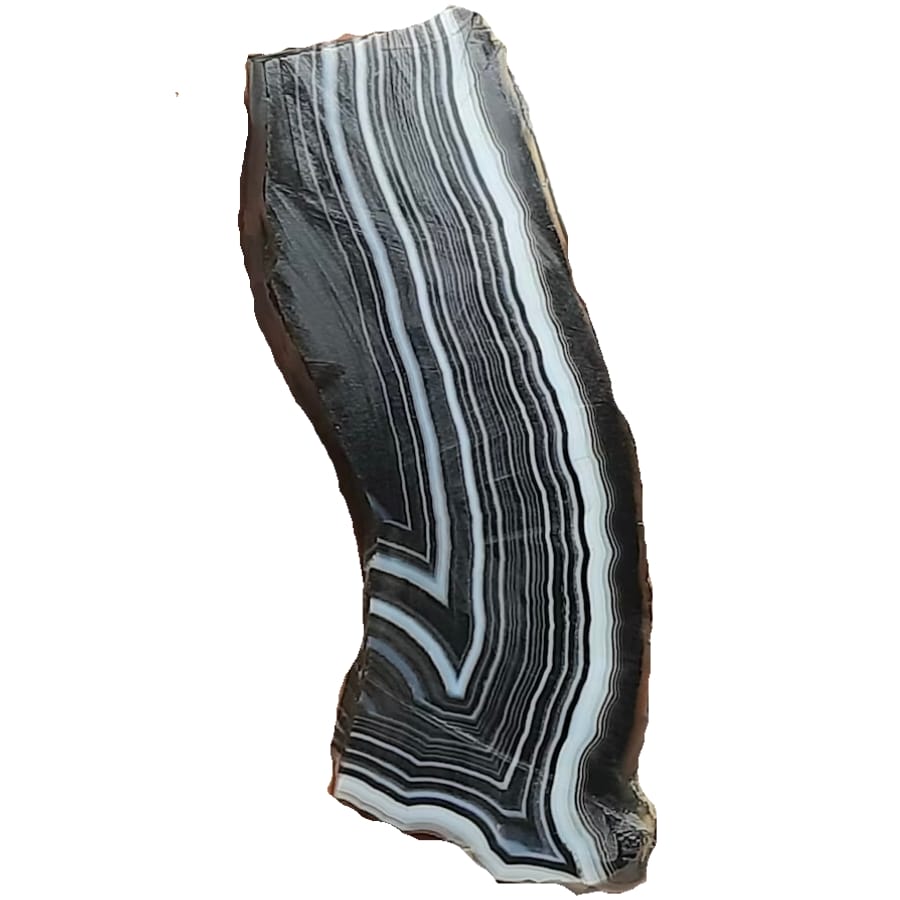
Real onyx has very neat bands of color. These bands are usually black and white or different shades of just one color. They’re like lines that run across the stone, making a kind of layered look.
In fake onyx, these bands often don’t look as neat. They might be wavy, crooked, or uneven. Some fakes might not even have clear bands at all. They try to copy the look of this rock, but they can’t get those lines that real onyx has.
So, when you’re checking an onyx, pay close attention to the bands. If they’re consistent and clean, that’s a good sign it’s real. If they’re messy or inconsistent, the stone might be fake.
Check its transparency

Transparency means how much light can pass through the stone. Real onyx isn’t completely see-through. It’s more like a very dark glass where some light can pass through, but you can’t clearly see through it.
If the onyx is fake, especially if it’s made of glass or plastic, it might be more transparent. This means you might be able to see more clearly through it, or it lets a lot of light pass through.
Try holding the onyx up to a light source. If you can see through it too easily, like looking through a window, it’s probably not genuine. Real onyx will block most of the light, showing its quality and authenticity.
Do a water test
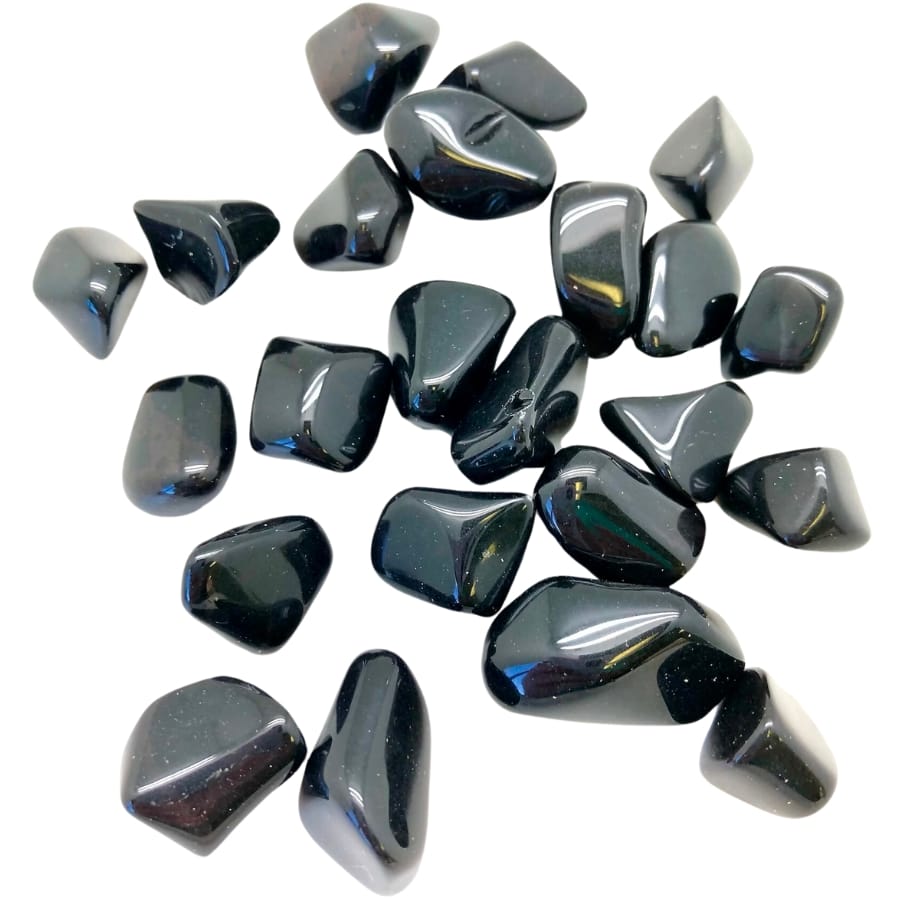
Here’s how you do a water test: put a drop of water on the surface of the onyx. If it’s real, the water will stay as a drop for a little while before slowly getting absorbed or evaporating.
This happens because real onyx has a dense structure. It doesn’t let water in easily but it absorbs it slowly.
If the onyx is fake, the water might just sit there and not get absorbed at all. Fake materials are usually non-porous, which means they don’t have tiny spaces for the water to go into.
Feel its texture
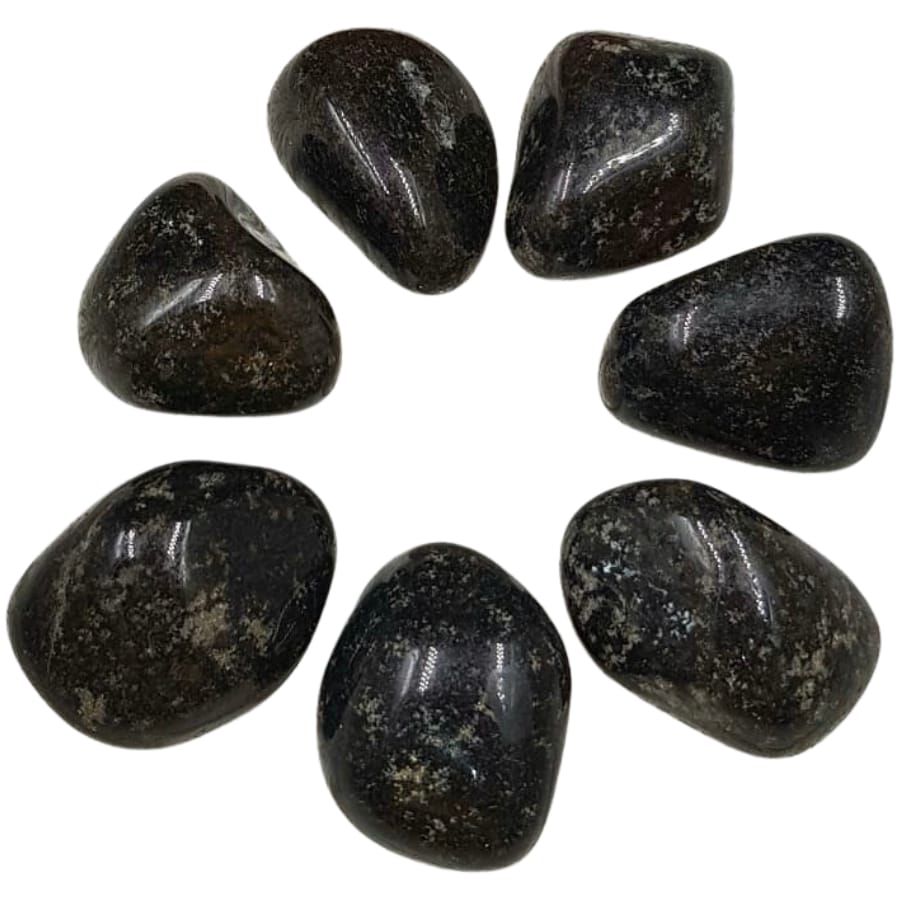
Real onyx has a smooth, waxy feel to it. When you touch it, it should feel kind of like touching a smooth piece of wax or a polished piece of glass. It’s smooth, but not too slippery.
If the onyx feels too plastic-like or too glassy, that’s a sign it might be fake. Fakes are often made from plastic or glass, which feel different from real rocks. Plastic might feel lighter and more like a toy, while glass might feel too hard and cold.
When you’re checking an onyx, take a moment to feel its surface. If it has that smooth, waxy texture, it’s more likely to be real. If it feels off, like too light or too hard, then you might be holding a fake.
The Different Types Of Fake Onyx And What They Look Like
A key measure to avoid mistaking fake onyx for a real one is to get familiar with them. This way, you’ll know how to decipher real onyx from their mere lookalikes. Below are some of the most common fake onyx out there:
Glass or Plastic Imitation

Glass and plastic are often used to make fake onyx because they can be shaped and colored to look pretty similar to the real thing.
For glass imitations, they start with clear glass and add black coloring to make it look like onyx. Glass is a good choice because it’s shiny and can be polished to look really smooth. They can even add artificial bands to mimic onyx’s famous banding.
Plastic imitations are even easier to make. Plastic is super versatile and can be made into almost any shape and color. To create fake onyx, they mix black dye into the plastic during the manufacturing process. They can also make bands to it.
Both glass and plastic are cheaper materials than real onyx, which is why they’re used for making fakes. These fakes can look pretty convincing at first glance, especially if you don’t know what to look for.
How you can identify glass or plastic imitation being sold as real onyx
Check the weight
Glass and plastic imitations are usually different in weight compared to real onyx. Glass is heavier and feels more solid, while plastic is much lighter. This difference in weight can be a big clue that they’re not real onyx.
Feel the temperature
Real onyx stays cool to the touch, even if it’s been in a warm room. Glass and plastic, however, warm up more quickly when you hold them.
Look at the surface
Onyx has a unique waxy shine, but glass and plastic fakes are often too shiny or too glossy. Fake onyx made of plastic might also have tiny scratches or a less smooth surface.
Agate
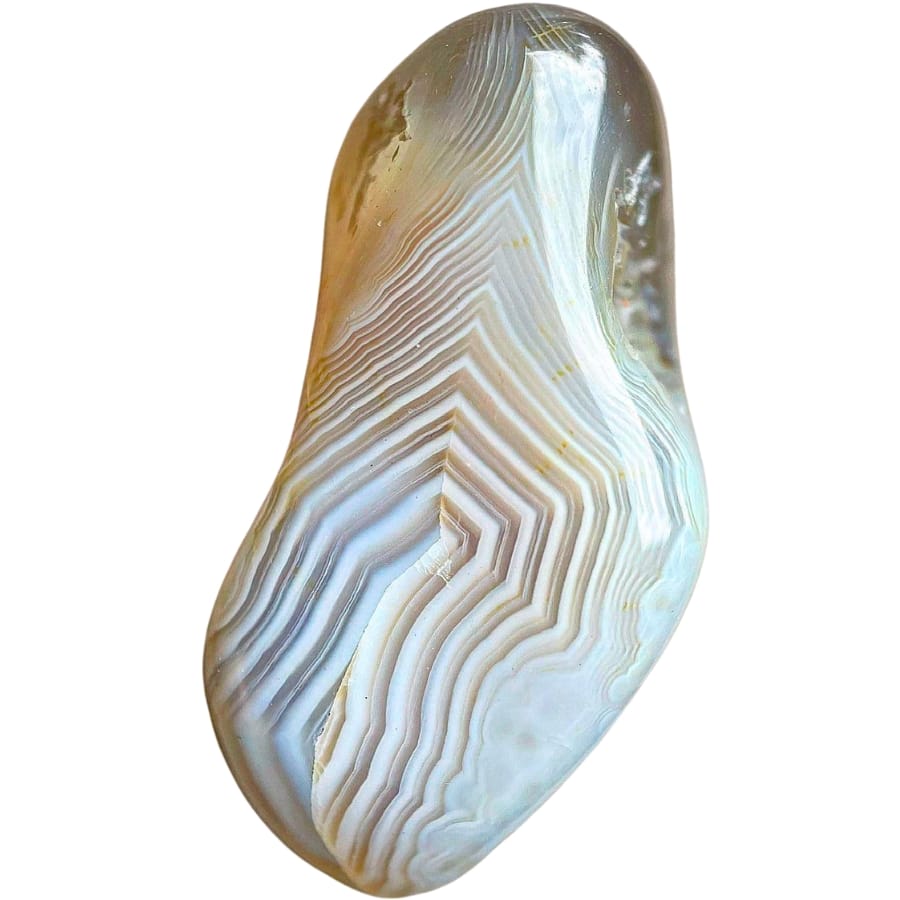
Agate and onyx are actually related: they’re both types of chalcedony. But they form in different ways, and that’s what makes them unique.
Agate forms when silica from water fills cavities in rocks. Over time, this silica turns into layers of chalcedony and quartz, creating bands of different colors. These bands can be all kinds of colors, like red, blue, brown, and even black.
To sell agate as onyx, they often use a black dye. Since it naturally has many colors and patterns, they choose ones that are already somewhat dark. Then, they put it in a dye that seeps into the stone, turning it a deep, even black.
This makes it look a lot like real onyx, which is naturally black or very dark.
Agate is easier to find and less expensive than real onyx, which is why it’s often used for imitation. Once dyed, it can be cut and polished to make it look even more like onyx.
How you can identify agate being sold as real onyx
Look at the bands
Onyx has parallel bands of color, usually black and white. Agate, on the other hand, has bands that are more curved, varied, and often in different colors, even if it’s dyed black.
Check the colors
Real onyx is mostly black or dark. If the stone has multiple colors or shades other than black, especially when held up to the light, it might be dyed agate.
Feel the texture
Onyx has a very smooth, waxy feel. Agate can feel similar, but it might not be as smooth and can sometimes feel a bit more grainy.
Obsidian
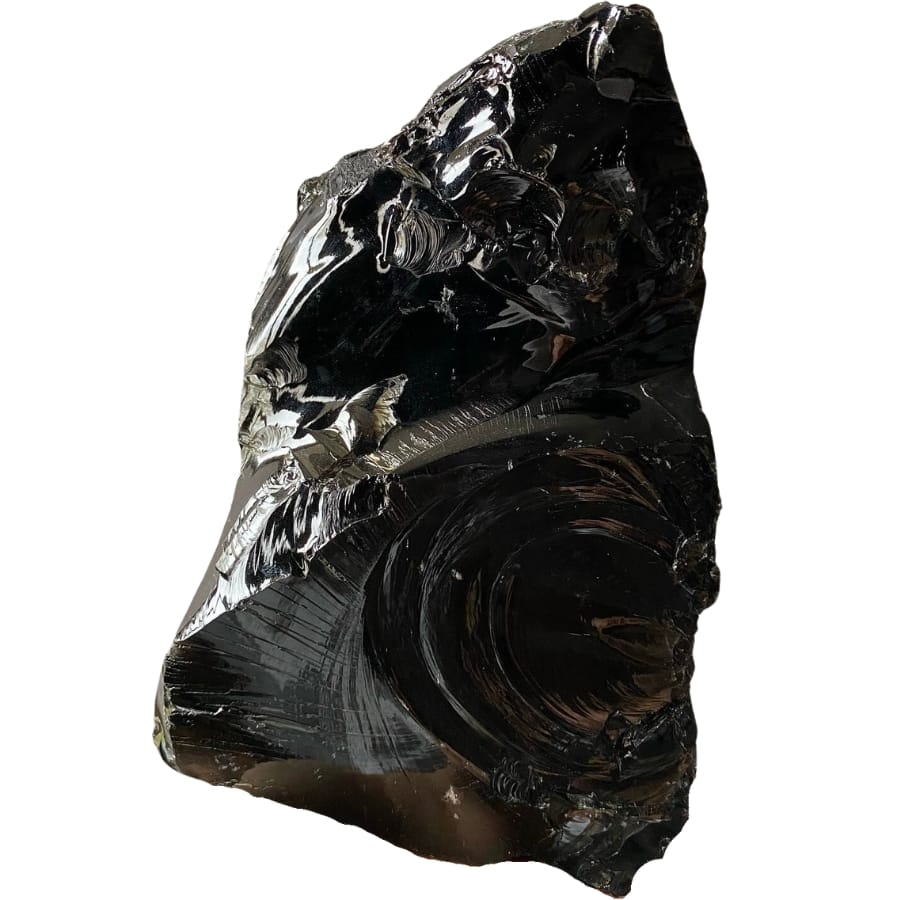
Obsidian is usually black and very shiny, which is why people sometimes mistake it for onyx. But they are formed in totally different ways.
Obsidian is a volcanic glass that’s made when lava cools down super fast. This happens when hot lava hits water or the air. This quick cooling doesn’t give the minerals in the lava enough time to form crystals, so instead, they become glass.
To sell obsidian as onyx, people often polish it to make it super smooth and shiny. This makes it look a lot like onyx, which is also known for its smoothness and shine. It’s also shaped into beads for jewelry or carved into different items, just like onyx.
But there are ways to tell obsidian vs onyx apart, as you can see below.
How you can identify obsidian being sold as real onyx
Look for a glassy appearance
Obsidian is a type of natural glass, so it has a very shiny, glass-like surface. Real onyx, while also shiny, doesn’t look as glassy as obsidian.
Check for small bubbles or lines
Since obsidian forms quickly from lava, it often has tiny bubbles or lines in it. Onyx, formed over time from mineral deposits, doesn’t have these features.
Feel the edges
Obsidian can have sharp edges, like glass, because of the way it breaks. Onyx, on the other hand, tends to have smoother, more rounded edges.
Black Chalcedony
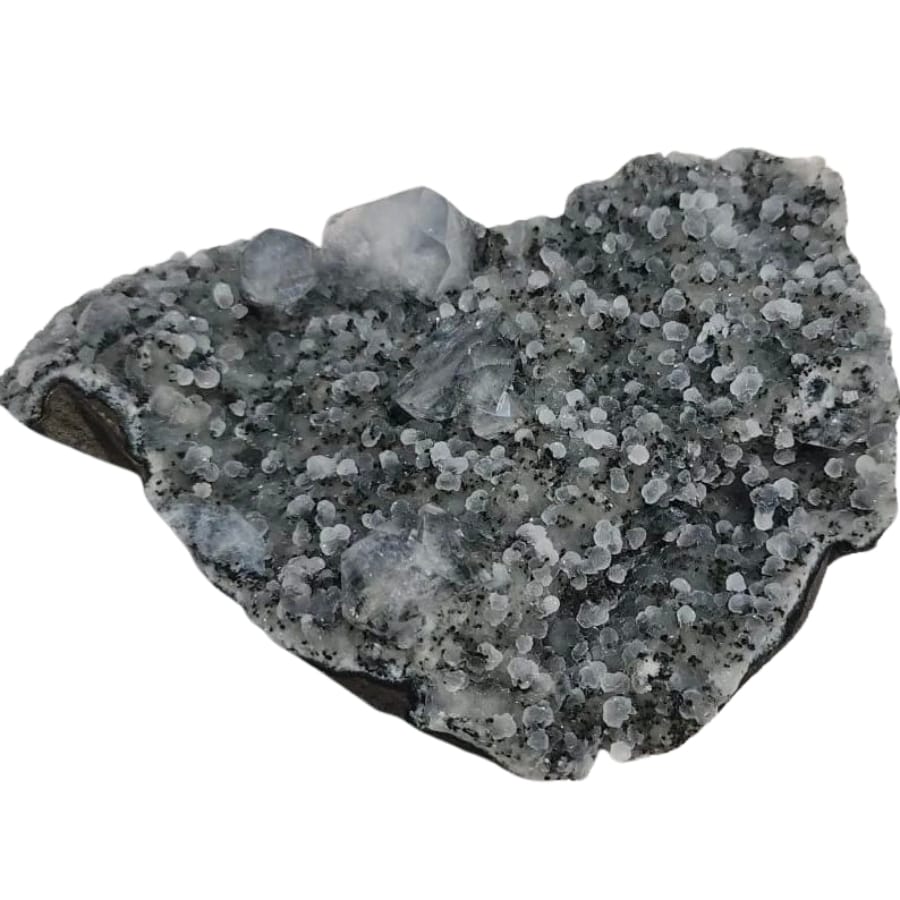
Just like onyx, black chalcedony is also a part of the quartz family. It forms when water full of silica seeps into cracks and spaces in other rocks. It hardens over time and as it does, it turns into chalcedony.
When this chalcedony is mixed with other minerals, like iron or manganese, it can become black chalcedony.
People might sell black chalcedony as onyx because they look similar at first glance. To make it look even more like real onyx, they might polish it until it’s really shiny and smooth.
They also shape it into beads for jewelry or carve it into different things, just like they do with onyx. But the trick to telling them apart is to look closely.
How you can identify black chalcedony being sold as real onyx
Look for banding
Real onyx has parallel bands of color, often black and white. Black chalcedony disguised as onyx is usually just one solid color without these distinctive bands.
Check the color depth
Onyx usually has a deep, consistent black color, whereas black chalcedony that is made to look like onyx might have slight variations in color or a less intense black.
Feel its texture
Both onyx and black chalcedony can be polished to be smooth, but onyx often has a more waxy feel. Black chalcedony might feel a bit different, less waxy, and more like other types of quartz.
Jet
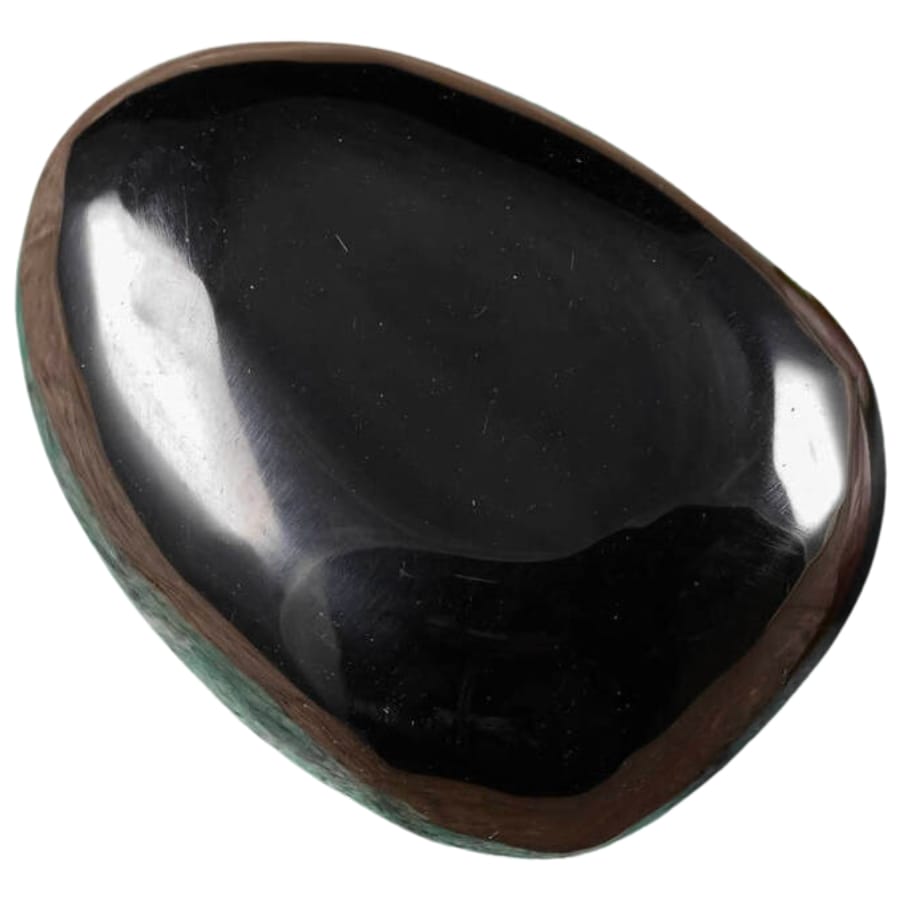
Jet is a really interesting kind of stone because it’s not like most other gems. It’s actually made from wood that got buried in the earth millions of years ago.
This wood got pressed down under lots of layers of mud and other stuff, and with all that pressure and no air, it slowly turned into a jet.
This makes jet a kind of coal, but it’s different because it’s really hard and can be polished to look shiny.
Jet is black, and when it’s polished, it can look a lot like onyx. That’s why sometimes people might try to sell jets as onyx. They polish it up and maybe even shape it into beads for jewelry.
How you can identify jet being sold as real onyx
Do a weight test
Jet is much lighter than onyx because it’s made from fossilized wood. If the stone feels surprisingly light for its size, it might be jet, not real onyx.
Try a scratch test
Jet is softer than onyx. If the stone gets scratched easily with something sharp, like a metal tool, it’s likely a jet that’s made to look like onyx.
Check the shine
Jet has a different kind of shine compared to onyx. Real onyx is glossy, while jet disguising as onyx has a more subtle, almost velvety shine.
How To Tell If Onyx Is Real Vs Fake
Aside from the ones we already shared, there are other kinds of fake onyx that might be sold to you for the price of a real one. So to avoid getting duped, here’s how you can identify fake onyx.
How to identify fake onyx when it’s cut or polished
This one here is a bit tricky. After all, it’s easier to manipulate a rock to look like onyx once it’s cut or polished, so here are a few things you should look out for in fake onyx:
Uneven or wavy bands
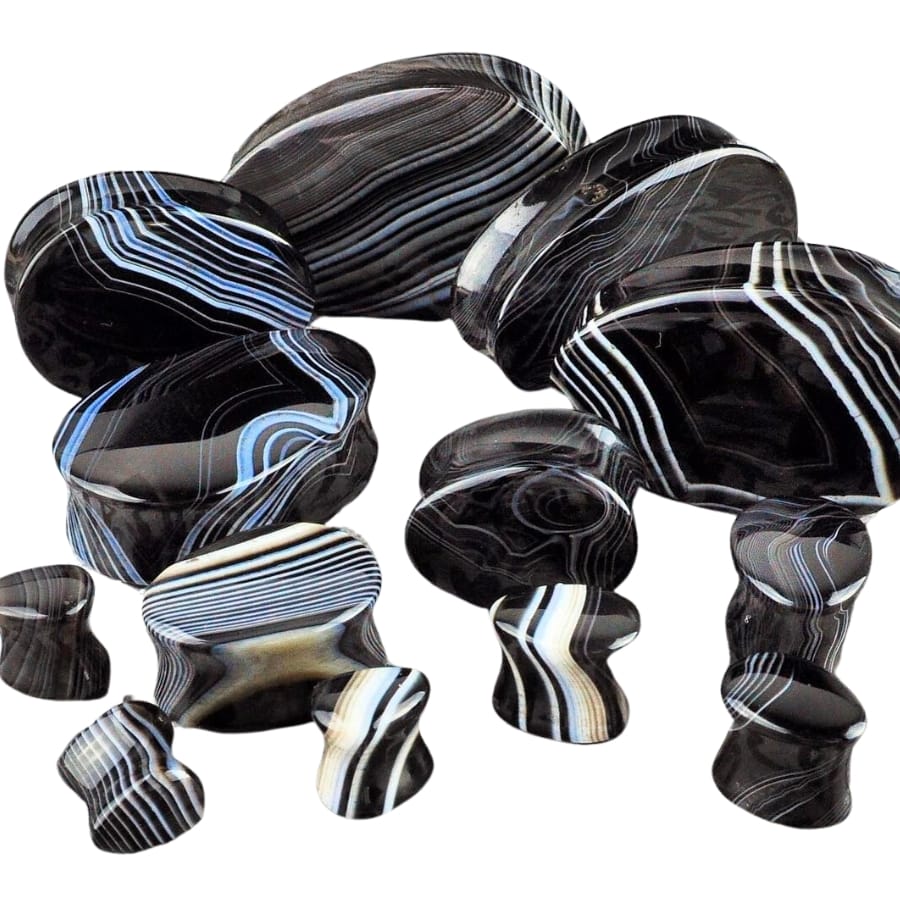
In real onyx, the bands are neat, like drawn lines. They run parallel to each other and are evenly spaced.
When it’s fake, like if it’s made from glass, plastic, or other types of rocks and minerals, the bands often don’t look right. They might be uneven or wavy, not straight and parallel like in real onyx.
Imagine drawing lines with your hand without a ruler— they might turn out a bit wobbly or uneven. That’s how the bands in fake onyx can look.
When people make fake onyx, they try to copy the look of the real bands, but it’s hard to get them clean. In glass or plastic, these bands are often painted or printed on, so they might not line up correctly.
In other rocks and minerals used to imitate onyx, the natural banding of that material doesn’t match the neat bands of real ones.
Easily scratched
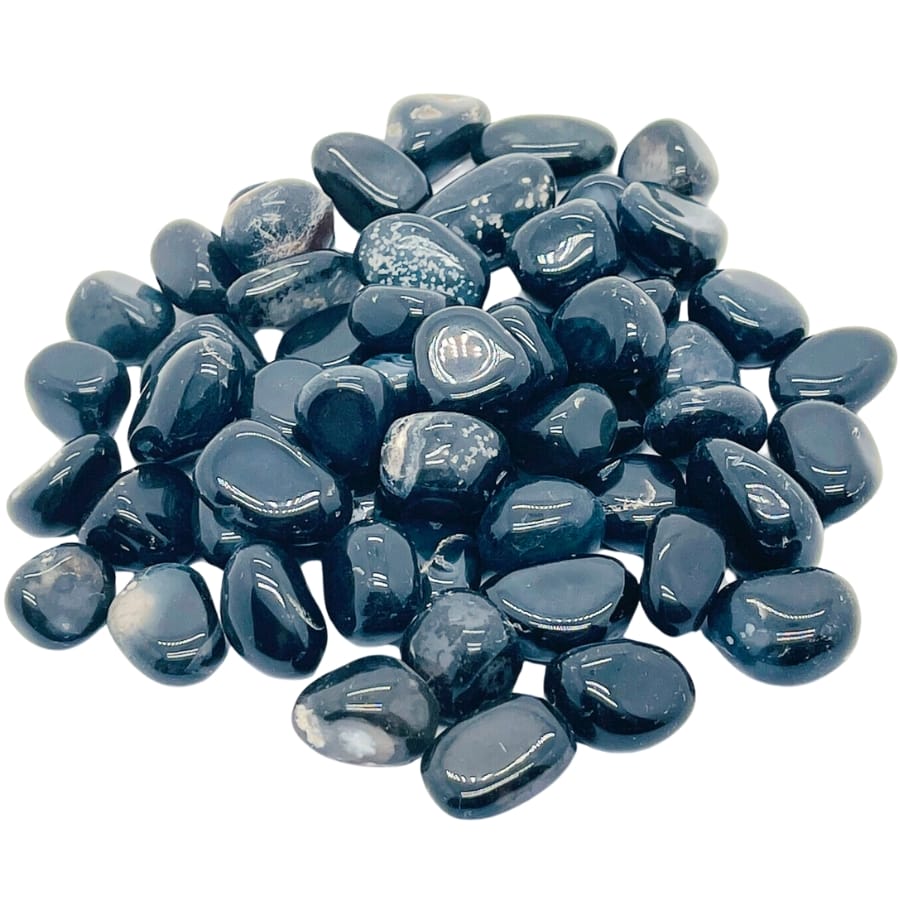
Real onyx is a pretty tough stone. This is important when you’re trying to figure out if it’s real or fake. Fake onyx can be made from different materials that may not be as hard as real onyx.
If you take something like a metal nail or a key and gently scratch the surface of the onyx, pay attention to what happens. With real onyx, it’s hard to leave a scratch. You might not see any mark at all, or if you do, it’ll be very light.
But if the onyx is fake, it’s a different story. Glass can get scratched, so if you can easily make a clear, noticeable scratch, it could be a sign of glass. Plastic is even softer. It gets scratched super easily, and the marks are usually obvious.
Completely transparent or opaque
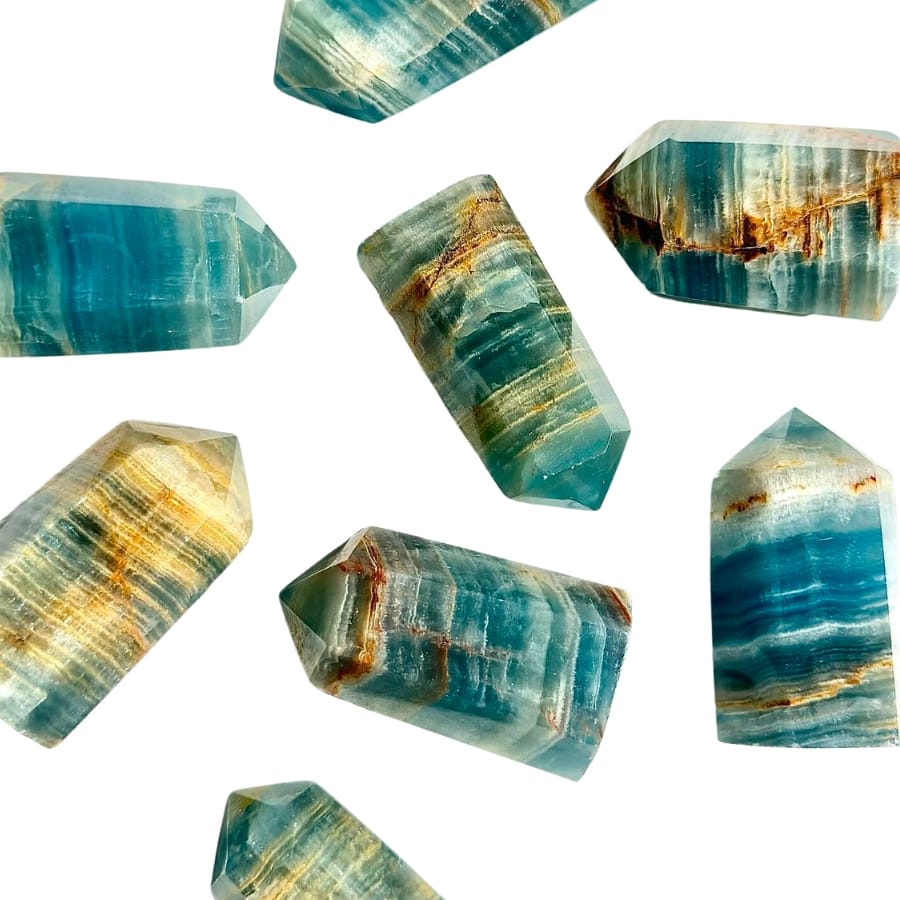
Another thing to look at is how much light can pass through your onyx. This is about whether it’s transparent (like clear glass where you can see through it) or opaque (where you can’t see through it at all).
Real onyx is kind of in the middle: it’s not completely see-through, but it’s not totally opaque either. In contrast, fake onyx is often either too transparent or too opaque.
So when you’re checking an onyx stone, try holding it up to a light source. Real onyx will block some light but not all of it. If it’s completely clear or totally blocks all light, there’s a good chance it’s a fake.
How to identify fake onyx when it’s raw
When it’s in its raw form, identifying fake onyx is also quite challenging. Here are some characteristics that will give away a fake onyx:
Consistent and uniform color
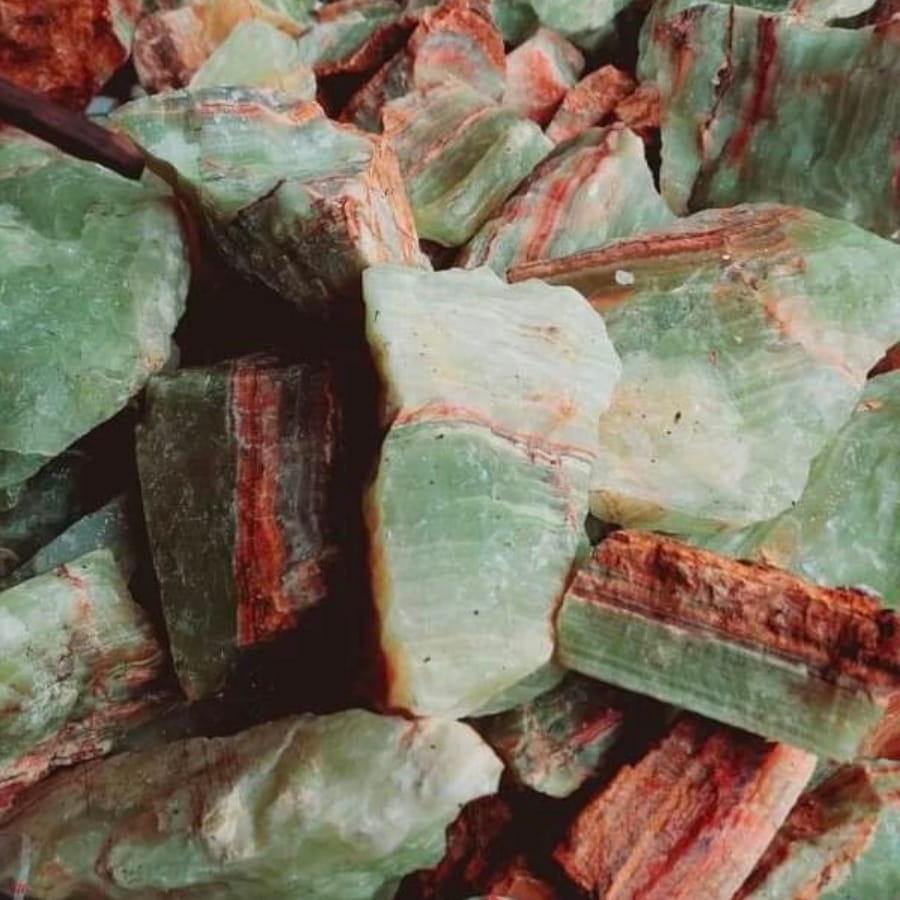
Real onyx is known for its beautiful bands of colors that are usually pretty clean and run parallel to each other. But the key thing is, even in these bands, the color of real onyx isn’t exactly the same all over.
You might see some slight changes in the shade or intensity of the color in different parts of the stone. This is because it’s a natural stone, and in nature, it’s rare to find something with a perfectly uniform color.
If you find a piece of onyx that has a color that looks the same everywhere, be cautious. A consistent, uniform color in a raw and uncut stone could be a sign that it’s fake.
This could mean that the stone has been dyed to look like onyx, or it’s made from something else entirely.
Rough texture
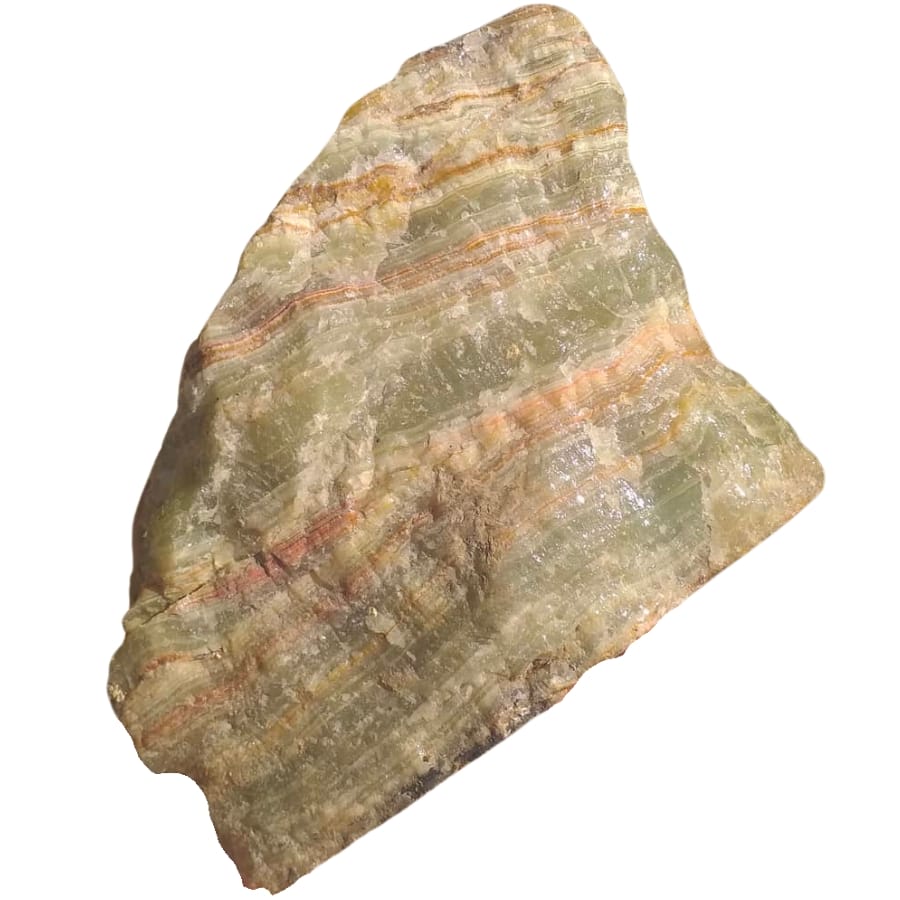
When you pick up a piece of raw and uncut onyx, one of the first things you’ll notice is how it feels. Real onyx has a pretty smooth texture, even when it’s not cut and polished. It’s not exactly like glass, but it shouldn’t feel too rough or gritty.
But if you find a piece of onyx that feels really rough or bumpy, like sandpaper, that’s a clue it might be fake. Fake onyx can be made from different materials that might be rougher to touch, especially when they’re not polished.
In nature, even though onyx is formed in layers, these layers get pressed down so tightly over time that they become smooth. That’s why real onyx, even in its raw form, should feel somewhat smooth.
Lightweight
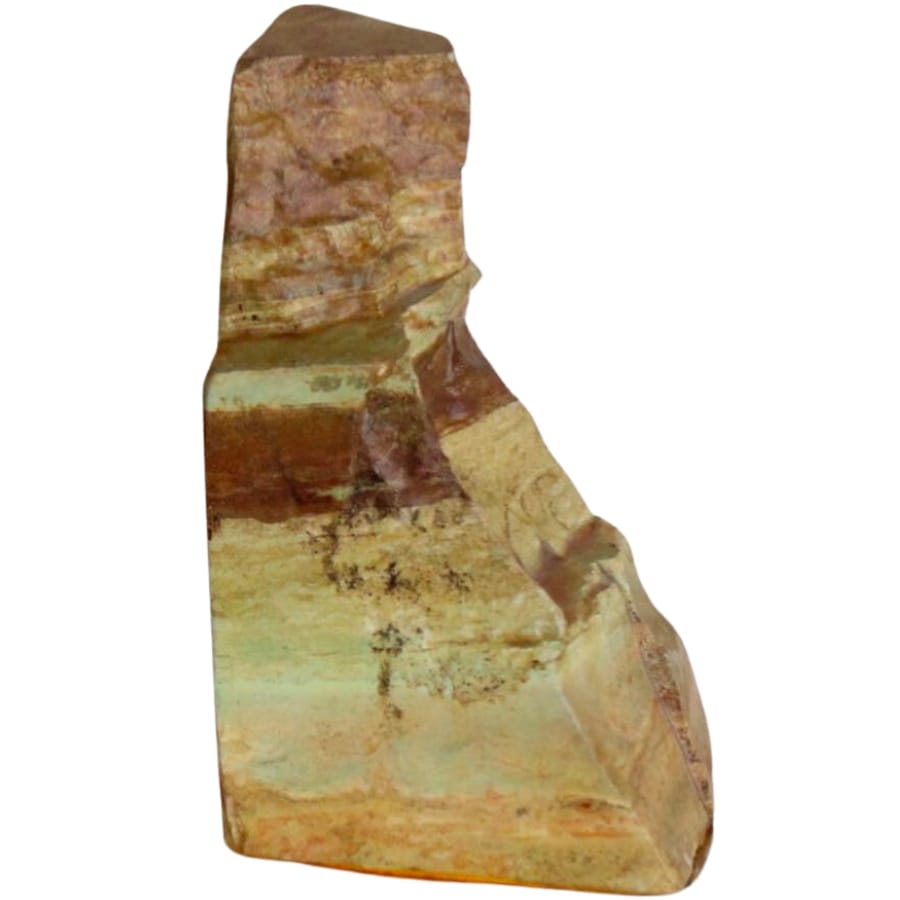
Real onyx has a certain weight to it. It should feel solid and a bit heavy for its size. This is a good hint because real stones, like onyx, are usually denser and heavier than things that look like stones but aren’t.
If you pick up a piece of onyx and it feels surprisingly light, like it’s not as heavy as you’d expect a stone to be, that’s a clue it might be fake.
Fake onyx can be made from materials like plastic or lightweight artificial stone, which don’t weigh as much as real onyx. These materials are easier and cheaper to get, so they’re often used to make fakes.
So, when you’re checking out a piece of onyx, take a moment to feel its weight. Remember, the weight of the stone can tell you a lot!


